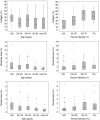Mammographic density, lobular involution, and risk of breast cancer
- PMID: 18781174
- PMCID: PMC2579686
- DOI: 10.1038/sj.bjc.6604635
Mammographic density, lobular involution, and risk of breast cancer
Abstract
In this review, we propose that age-related changes in mammographic density and breast tissue involution are closely related phenomena, and consider their potential relevance to the aetiology of breast cancer. We propose that the reduction in mammographic density that occurs with increasing age, parity and menopause reflects the involution of breast tissue. We further propose that age-related changes in both mammographic density and breast tissue composition are observable and measurable phenomena that resemble Pike's theoretical construct of 'breast tissue ageing'. Extensive mammographic density and delayed breast involution are both associated with an increased risk of breast cancer and are consistent with the hypothesis of the Pike model that cumulative exposure of breast tissue to hormones and growth factors that stimulate cell division, as well as the accumulation of genetic damage in breast cells, are major determinants of breast cancer incidence.
Figures



Similar articles
-
Mammographic density: a hormonally responsive risk factor for breast cancer.J Br Menopause Soc. 2006 Dec;12(4):186-93. doi: 10.1258/136218006779160436. J Br Menopause Soc. 2006. PMID: 17178021 Review.
-
Association between mammographic density and age-related lobular involution of the breast.J Clin Oncol. 2010 May 1;28(13):2207-12. doi: 10.1200/JCO.2009.23.4120. Epub 2010 Mar 29. J Clin Oncol. 2010. PMID: 20351335 Free PMC article.
-
Independent association of lobular involution and mammographic breast density with breast cancer risk.J Natl Cancer Inst. 2010 Nov 17;102(22):1716-23. doi: 10.1093/jnci/djq414. Epub 2010 Oct 29. J Natl Cancer Inst. 2010. PMID: 21037116 Free PMC article.
-
Circulating insulin-like growth factor-I, insulin-like growth factor binding protein-3 and terminal duct lobular unit involution of the breast: a cross-sectional study of women with benign breast disease.Breast Cancer Res. 2016 Feb 18;18(1):24. doi: 10.1186/s13058-016-0678-4. Breast Cancer Res. 2016. PMID: 26893016 Free PMC article.
-
Mammographic density. Potential mechanisms of breast cancer risk associated with mammographic density: hypotheses based on epidemiological evidence.Breast Cancer Res. 2008;10(1):201. doi: 10.1186/bcr1831. Epub 2008 Jan 9. Breast Cancer Res. 2008. PMID: 18226174 Free PMC article. Review.
Cited by
-
Lobular involution, mammographic density, and breast cancer risk: visualizing the future?J Natl Cancer Inst. 2010 Nov 17;102(22):1685-7. doi: 10.1093/jnci/djq433. Epub 2010 Oct 29. J Natl Cancer Inst. 2010. PMID: 21037117 Free PMC article. No abstract available.
-
Age-related terminal duct lobular unit involution in benign tissues from Chinese breast cancer patients with luminal and triple-negative tumors.Breast Cancer Res. 2017 May 25;19(1):61. doi: 10.1186/s13058-017-0850-5. Breast Cancer Res. 2017. PMID: 28545469 Free PMC article.
-
Involution of Breast Lobules, Mammographic Breast Density and Prognosis Among Tamoxifen-Treated Estrogen Receptor-Positive Breast Cancer Patients.J Clin Med. 2019 Nov 4;8(11):1868. doi: 10.3390/jcm8111868. J Clin Med. 2019. PMID: 31689948 Free PMC article.
-
Stroma modifies relationships between risk factor exposure and age-related epithelial involution in benign breast.Mod Pathol. 2018 Jul;31(7):1085-1096. doi: 10.1038/s41379-018-0033-7. Epub 2018 Feb 20. Mod Pathol. 2018. PMID: 29463881 Free PMC article.
-
Mammographic density, blood telomere length and lipid peroxidation.Sci Rep. 2017 Jul 19;7(1):5803. doi: 10.1038/s41598-017-06036-y. Sci Rep. 2017. PMID: 28725051 Free PMC article.
References
-
- American College of Radiology (2003) American College of Radiology (ACR) Breast Imaging Reporting and Data System (BI-RADS), 4th edn. Reston, VA
-
- Bartow SA, Pathak DR, Black WC, Key CR, Teaf SR (1987) Prevalence of benign, atypical and malignant breast lesions in populations at different risk for breast cancer. A forensic autopsy study. Cancer 60: 2751–2760 - PubMed
-
- Boyd N, Martin L, Stone J, Little L, Minkin S, Yaffe M (2002a) A longitudinal study of the effects of menopause on mammographic features. Cancer Epidemiol Biomarkers Prev 11: 1048–1053 - PubMed
-
- Boyd NF, Guo H, Martin LJ, Sun L, Stone J, Fishell E, Jong RA, Hislop G, Chiarelli A, Minkin S, Yaffe M (2007) Mammographic density and the risk and detection of breast cancer. N Engl J Med 356: 227–236 - PubMed
-
- Boyd NF, Dite GS, Stone J, Gunasekara A, English DR, McCredie MRE, Giles GG, Tritchler D, Chiarelli A, Yaffe MJ, Hopper JL (2002b) Heritability of mammographic density, a risk factor for breast cancer. N Engl J Med 347: 886–894 - PubMed
Publication types
MeSH terms
LinkOut - more resources
Full Text Sources
Medical

